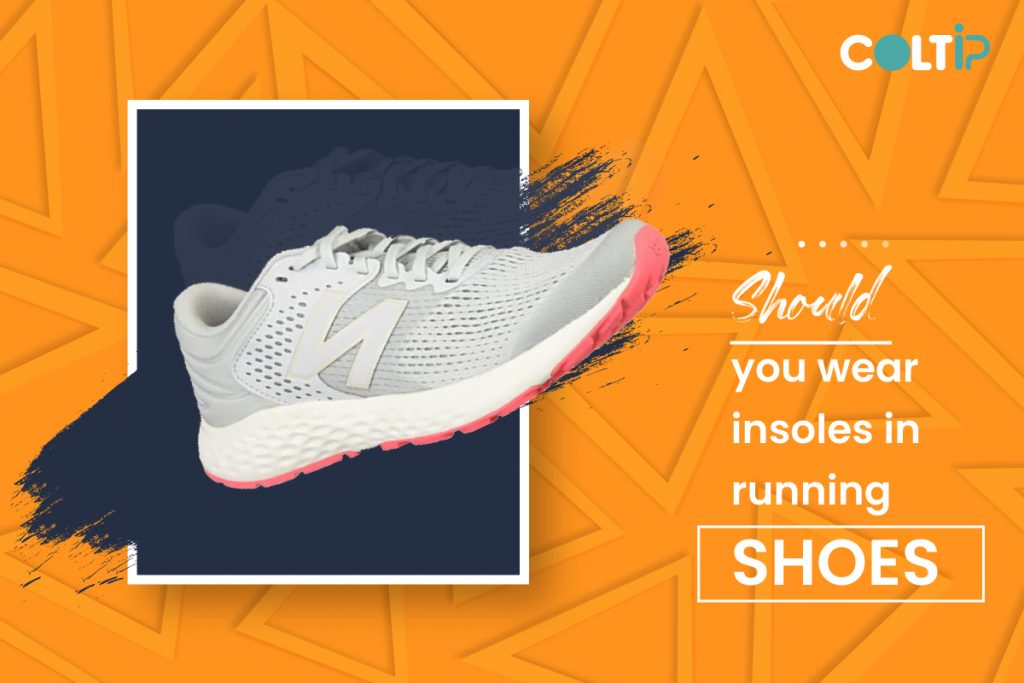Table of Contents
Introduction:
Runners sometimes feel puzzled about whether they should use insoles in their running shoes. This guide is here to help, covering the good things about insoles, things to think about, and signs that show should you wear insoles in running shoes? We’ll look at different views, including what the experts say, to help you decide wisely.
What Are Running Insoles?
Running insoles, also called shoe inserts or orthotics, provide extra cushioning and support for your running shoes. It’s important to recognize the difference between the insole that comes with your shoe and the additional insoles you can buy. The one that comes with your shoe is usually thin and doesn’t provide much support, but running insoles have different designs to meet various training requirements.
Should You Wear Insoles in Running Shoes?
Wearing insoles in your running shoes can make them more comfortable and supportive, taking care of specific foot problems. However, it’s important to think about your own situation. If you feel a lot of pain or discomfort while running, insoles can be like a custom-made solution, making your feet feel better and keeping everything in line.
But if you’re not having any pain and your feet and running style seem good, spending money on insoles might not be needed. Instead, getting some coaching to improve your running technique and dealing with any issues without using special inserts might be enough.
The choice of whether to wear insoles in your running shoes depends on your personal needs, finding the right balance for more comfort and dealing with any existing problems.
Who Needs Running Insoles?
Running insoles can really help different people, especially those dealing with foot issues or wanting more comfort and better performance when they run. Let’s look at who might get some benefits from using running insoles:
1. Individuals with Foot Pain or Discomfort
If your feet hurt often during or after your runs, adding insoles to your shoes can give them more support and make them feel better.
2. Runners with Alignment Issues
Insoles are like secret helpers for runners who might have funny ways of walking, such as rolling their feet too much or not enough. These helpers make sure your body lines up just right, kind of like a superhero making sure everything stays in order, so you’re less likely to get hurt from walking the wrong way.
3. Those Seeking Enhanced Comfort
Even if your feet feel fine, using insoles gives your running shoes extra padding, making your runs more comfy. It’s like adding a cozy layer to your shoes for a better running experience.
4. Individuals with Unevenly Worn Shoes
If you see your running shoe soles wearing out unevenly, it might mean your walking style has some problems. Insoles can help fix this by spreading the pressure more evenly and making your shoes last longer.
5. People Looking for Customization
Factory-made shoes might not suit the distinct contours of each person’s feet. Insoles present a tailored remedy, offering a custom fit that adjusts to the shape of your arch, heel, and toes.
6. Those Concerned about Injury Prevention
Insoles are like protective shields for your feet while running, helping to prevent injuries. They work by lessening the force on your feet and could lower the chances of getting problems like plantar fasciitis, shin splints, and stress fractures.
7. Individuals Looking for Performance Improvement
For dedicated runners looking to boost their performance, using insoles can make running more comfortable by absorbing shocks and giving extra energy when pushing off with your toes. This helps you run more efficiently and smoothly.
8. Athletes Engaging in Various Sports
It’s not just about running; players in different sports, like soccer or basketball, can find value in custom insoles made to meet the unique needs and motions of those activities.
Who Doesn’t Need Running Insoles?
Although running insoles can be helpful for some people, there are situations where they might not be needed. Let’s explore when individuals might not require running insoles:
1. Pain-Free Runners
If your feet feel good and you don’t have pain when you run, you might not need special insoles. Some lucky runners don’t need extra support because they already feel comfortable and pain-free.
2. Those with Properly Fitted Shoes
If your running shoes fit well and give good support to your feet, you might not have to add extra insoles. Really good running shoes usually come with special features that give your feet the right amount of cushioning and support.
3. Individuals with Neutral Gait
If you’re a runner with a regular way of walking, where your feet don’t roll too much inside or outside, the regular insoles that come with your running shoes could be enough to support you. In situations like this, you might not need extra insoles to fix how you walk.
4. Runners Not Looking for Customization
Many runners discover that the regular insoles in their shoes work just fine for them. If you’re not looking for a personalized fit or don’t feel any discomfort, the original insoles should be good enough for your running needs.
5. People on Professional Advice
If a foot expert like a podiatrist or sports doctor checks how you walk and the shape of your feet and recommends not using insoles, it’s important to listen to them. They give personalized advice based on the special needs of your feet.
6. Individuals without Wear Patterns
If your running shoes look evenly worn on the soles, and you don’t feel any big problems with how your weight is spread, you might not need extra insoles. If your shoes wear evenly, it means they’re doing a good job supporting how you naturally walk or run.
7. Runners Content with Performance
If you’re happy with how you run and don’t encounter any issues, you might not need fancy insoles to boost your performance. It’s totally fine to stick with what works for you!
Understanding the Benefits:
Insoles for running make your runs much better! They add comfort, give support, and help with specific foot problems. Let’s check out some important perks:
1. Improved Comfort and Support
Custom insoles provide enhanced comfort tailored to your needs, fixing the limitations of the standard insoles that come with your running shoes. They make your feet feel supported and cozy by giving a gentle hug to the bottom of your foot, ensuring the best possible comfort and minimizing any discomfort.
2. Alignment Correction
Insoles can help correct alignment issues, catering to different running styles such as pronation, neutral running, or supination. They contribute to fostering a stride that mimics the natural movement of the feet, thereby minimizing the chances of injuries linked to improper foot motion.
3. Shock Absorption
The extra support and padding in running insoles do a great job soaking up the impact and energy created when you run. This is super important because it helps to lessen the strain on your feet, especially when you’re running on tough surfaces like sidewalks or trails.
Do You Need Running Insoles?
Deciding if you should use running insoles includes thinking about things like any foot pain, how your shoes are wearing out, and how your running feels overall. Now, let’s explore some important signs:
1. Experiencing Pain
If you feel strong or lasting pain while running, especially in spots like your heel, it might mean your shoes don’t give enough support. Using running insoles can really help ease discomfort connected to issues like plantar fasciitis or landing on your heels.
2. Uneven Shoe Wear
Take a look at the bottoms of your running shoes – they can tell you a lot about how you run. If one side is more worn out than the other, it could mean you’re leaning too much to one side while running. Using insoles in your shoes can help fix how you run, making your shoes last longer.
3. Preference for Comfort
Even if you don’t feel any obvious discomfort, choosing insoles can make your shoes more comfortable. Regular shoes are made to fit many people, but everyone’s feet are different. Insoles are an easy and effective way to personalize your running shoes, making sure they fit perfectly with support for your arch, heel, and toes.
Are Running Insoles Worth It?
Runners often wonder whether the benefits of running insoles are worth the cost. Let’s check if spending money on insoles is a good idea:
1. Cost versus Comfort
Despite appearing as an extra cost following the purchase of high-quality running shoes, think of insoles as a way to protect yourself from getting hurt. By reducing the chances of problems like shin splints and plantar fasciitis, insoles can actually save you money in the long run by helping you avoid costs associated with running injuries.
2. Customization for Comfort
Insoles turn regular running shoes into a special pair that fits your feet just right. They mold perfectly to your foot shape, making your runs way more comfy. Think of it like a secret ingredient that makes your running experience better and might even keep you from feeling uncomfortable or getting hurt.
Final Thoughts:
In short, deciding to wear insoles in your running shoes depends on things like how comfy you feel, if you’re feeling any pain, and how your shoes are wearing out. If you understand the benefits and think about what you need, you can make a smart choice. Insoles for running can really help by giving support, fixing how you stand, and making your runs more comfortable. Talk to experts, try out different insoles, and make sure you’re looking out for your comfort and well-being while running.
What are the benefits of running insoles?
Running insoles can provide extra cushioning and support, which can help to reduce the risk of injury. They can also help to absorb shock and improve comfort.
What are the different types of running insoles?
There are three main running insoles: arch support, heel support, and cushioning insoles. Each type offers different benefits.
How do I choose the correct insole for my needs?
To choose the correct insole for your needs, you must consider a few factors:
You need to figure out what type of insole you need.
You need to determine the size of your insole.
You need to consider the kind of material that the insole is made from.
You need to decide how much support you need.
It would be best to consider the fit of the insole.
It’s essential to make sure that the insole is the right size and fits comfortably in your shoe.
How do I care for my running insoles?
To care for your running insoles, you need to carefully read the manufacturer’s instructions. Each insole is made from different materials and requires an extra level of care.
It would be best to clean your insoles regularly using a damp cloth. You should store your insoles in a cool, dry place and replace them when they show signs of wear and tear.
You should never use harsh chemicals or abrasive materials to clean your insoles. This can damage them and reduce their lifespan.
Can running insoles help to prevent injuries?
Running insoles can help reduce the risk of injury, but they are not a guarantee against injury.
It’s essential always to wear shoes that fit well and provide adequate support, stretch before you run, and drink plenty of water.
You should also vary your running routine and take periodic breaks from running.
If you experience pain or discomfort while running, see a doctor. This could be a sign of an underlying injury.



